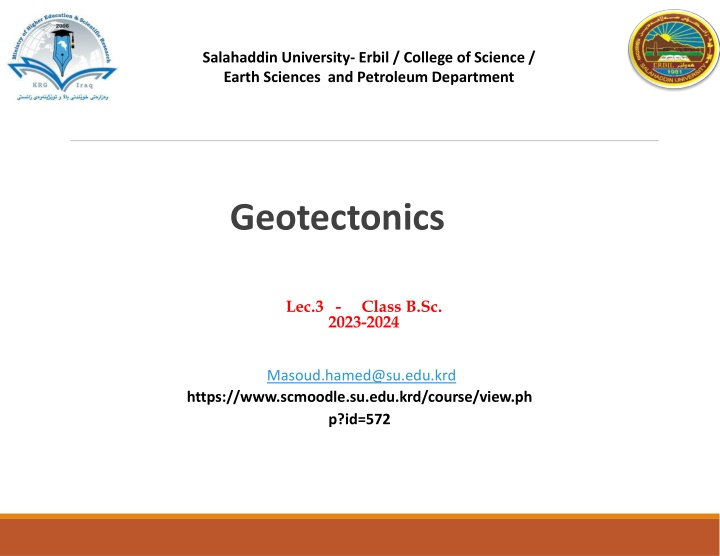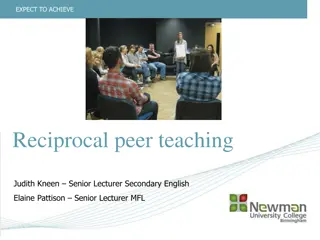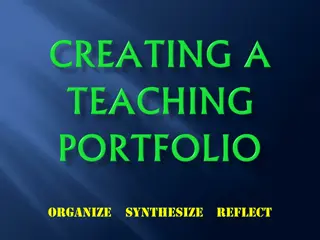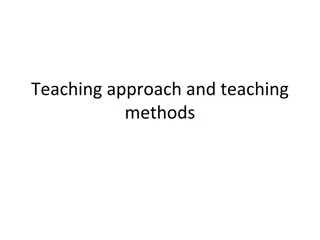
Plate Tectonics: Overview and Impacts on Earth's Landscape
"Explore the fascinating world of plate tectonics through this course at Salahaddin University, focusing on plate motions, earthquakes, volcanoes, and more. Learn about the role of lithosphere and asthenosphere, theories of continental drift, and the significance of plate behavior in predicting earthquakes and volcanic activity. Discover the structure of tectonic plates and the layers of the Earth, gaining valuable insights into the geological forces shaping our planet's surface. Enroll now to grasp the fundamentals of geotectonics and enhance your understanding of Earth's dynamic processes."
Download Presentation

Please find below an Image/Link to download the presentation.
The content on the website is provided AS IS for your information and personal use only. It may not be sold, licensed, or shared on other websites without obtaining consent from the author. If you encounter any issues during the download, it is possible that the publisher has removed the file from their server.
You are allowed to download the files provided on this website for personal or commercial use, subject to the condition that they are used lawfully. All files are the property of their respective owners.
The content on the website is provided AS IS for your information and personal use only. It may not be sold, licensed, or shared on other websites without obtaining consent from the author.
E N D
Presentation Transcript
Salahaddin University- Erbil / College of Science / Earth Sciences and Petroleum Department Geotectonics Lec.3 - Class B.Sc. 2023-2024 Masoud.hamed@su.edu.krd https://www.scmoodle.su.edu.krd/course/view.ph p?id=572
Overview on this course Plate motions, earthquakes, volcanoes, mountain building, landslides, floods and many others phenomena have interacted over long time to sculpt our present-day landscape. In this course, we present the impact of some of these phenomena, what each of them is, and what causes them. We will be mainly focusing on plate tectonics -the grand unifying theory of geology- to explain how the location of out plate (Arabian plate), which we are part of now, has changed radically over geologic time, and why present-day geologic activities including earthquakes and volcanic occur where they do. These all together would help us to understand the context of the environment and sustainability challengeswewill face in the future. 2
Objectiveof thislecture: Students after this lecture will be able to 1 Explain the role of the lithosphere and the asthenosphere in the motion of the plates. 2 Explain the relationship between theories of continental drift and plate tectonics. 3 Explain the mechanism of Paleomagnetism and its usage in measuring the age of sea-floorspreading and movementorientation of tectonic plates. 3
Whydoes understanding plate tectonicmatter? In Modern day geologic science, understanding plate behaviors helps scientists to better estimate landscape development in the feature based onhowplates have acted in the past. Understanding plate tectonics can give us clue why most of the earthquakes are located on Iraq-Iran-Turkey border! In short, it helps geologistsin predictingearthquakes andthen its precuation! Plate tectonic theorycanexplain causes ofvolcanicity. Plate tectonics explains whyandwheremountains/basins areformed. 4
Whatisatectonicplate? A tectonic plate (also called lithospheric plate) is a massive,irregularly shaped slab ofsolid rock, generally composed of both continental and oceanic lithosphere. Plate size can varygreatly, froma few hundred to thousands of kilometers across. Be careful thebordersof African plateare nottheedgesof the African continent! Which plateare we (Iraqi-Kurdistan)part of? How do these massive slabsof solid rockfloat despite their tremendousweight? Toanswerthis question we have to goover the internalstructureof the Earth! 5
Lets doaquick review ofStructure oftheEarth Weall know thatEarth hasbeen divided to different layers, see the picture! Layersofdifferent compositions: 1 Core(Iron) 2 Mantle 3 Crust Layersofdifferent strength: 1 Mesosphere 2 Asthenosphere 3 Lithosphere Dotheselayers soundfamiliartoyou?HopefullyYES! 6
Aquickquestion (polishing up previousknowledge!) Is the mantle solid or Liquid? A- solid B-Liquid Discuss it with your pal. White tack is solid! Lithosphere is like white tackLii tn hos b pe hh era evii so tr hs in !. When we pulled,it, it brakes! However Asthenosphere, It is brittle! beneath but and flow on well lithosphere, is still sold deformed! It is bended when we Asthenosphere is hotter, it moves around nicely! BUT LIQUID! put pressure it! IT IS NOT So,that is the structure of the deep interior of the Earth! But we liveon the surface! 7
Howdo weexplain patterns andfeatures onthe surface oftheEarth? Whatare the two typesofcrust wehave?Or Whatare the twobiggestdistinctions that youcansee here onthesurface? 8
Commonquestions thatwe(geologists) have beenstruggling oftoexplain! Whyare the continents where they are? Whyare theoceanswhere theyare? Whydoearthquakes and volcanoes occurin similar places? Whydoweget different kindof rocks togetherin some specific places? Why does Iraq-Iran-Turkey border has themostcomplex content geologywise!?Why dothiszone hasthehighestmountains?Why Hawler doesnothas anymountains?Have youever asked yourselfas ageologist? Suchquestions motivated earlier scientist tothink aboutamechanism to explain all ofthese questions,Soplatetectonictheorywasborn! 9
Continental Drift-anold idea 1596:Dutchmapmaker AbrahamOrtelius Thesaurus Geographics: Americas were tornawayfrom EuropeandAfrica Byearthquakesand floods ! 1858:maps bygeographerAntonioSnider-Pellegrini 1914:Alfred Wegenerproposed Continental Drift 10
ContinentalDrift-evidence Let sayyouwere Alfred Wegener andwanted to provethat the continents were once joined together, and hadmoved around, what sortof evidence would you look for? Or, what kindof evidence you thinkhe looked for? Write them downhere: 11
ContinentalDrift-evidence Wegener s evidence Continental shorelines seems tofit together! Matchingfossilson landmasses farapart. Matchingrocksand structures on the edges ofcontinents. Evidencefromfossils androcks showing climate zonesdidnot matchcurrent continent positions. 12



















